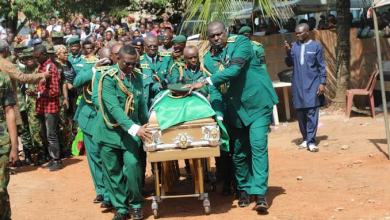NSIB Blames Aviation Authority Over Nigerian Helicopter Crash Probe, Reveals Lack of Flight Data Recorder

Nigerian Safety Investigation Bureau (NSIB) on Tuesday released its preliminary report on the helicopter crash involving a Sikorsky S76C+ operated by Eastwind Aviation.
The chopper crashed into the Atlantic Ocean off the coast of Bonny Finima, Port Harcourt, on October 24, 2024.
The helicopter, with registration 5N-BQG, was carrying eight passengers when it crashed.
The NSIB stated that the failure to fit a Flight Data Recorder (FDR) in the helicopter, contrary to part 7.8.2.2(q) of the Nigeria Civil Aviation Regulations (Nig. CARs) 2023, was a significant oversight.
The regulation mandates the installation of FDRs in such aircraft.
NSIB Director-General, Capt. Alex Badeh Jnr, expressed concern over this critical safety lapse.
The Nigerian Safety Investigation Bureau (NSIB) has urged the Nigerian Civil Aviation Authority (NCAA) to enforce the requirement for all helicopters exceeding 3,175 kg in maximum take-off weight to be equipped with operational Flight Data Recorder Systems (FDRS). This directive aligns with the stipulations outlined in the Nigerian Civil Aviation Regulations (Nig. CARs) 2023. The NSIB’s call emphasizes the importance of compliance with these regulations to enhance aviation safety standards across the country’s helicopter.
The Bureau also recommended the adoption of standard callouts and phraseology in flight operations, achieved through enhanced crew training. Additionally, it emphasized the need for comprehensive and accurate weather reports for operators, as well as ensuring precision in critical flight data.
Badeh urged both stakeholders and the public to give due attention to the safety recommendations in these reports, stating, “They offer invaluable lessons that must not be overlooked.
“The insights offered within these documents serve as crucial guidance for preventing future occurrences and ensuring the safety of all lives involved in transportation,” Badeh said.
However, he confirmed that the flight crew was properly certified to operate the flight at the time of the incident.
Badeh said so far, five bodies had been recovered while three others were yet to be found.
Meanwhile, the final reports presented include the Bell 429 Helicopter (5N-MDA) operated by the Nigeria Police Air Wing, which crashed on January 26, 2022, near Sir Abubakar Tafawa Balewa Airport in Bauchi; the Embraer 145LR (5N-BWW) of United Nigeria Airlines, which occurred on November 17, 2021; and the Max Air Embraer EMB-135BJ (5N-BXK), which crashed on April 26, 2022.
According to the report, during the flight, “the crew encountered worsening weather conditions, including inaccurate weather reports, and attempted to adjust the payload and altitude”.
He said, “Despite efforts to climb and stabilize, the helicopter crashed into the Atlantic Ocean, disintegrating upon impact,” the preliminary report indicated.”
He said five bodies were recovered, three others including the flight crew and one passenger were yet to be found as of the time of releasing the preliminary report.
“The preliminary report blamed the causal factor on “failure to maintain aircraft control in challenging weather conditions,” he said.
Badeh explained that the contributory factors include use of non-standard phraseology by the flight crew; absence of standard callouts during various flight phases; defective radio altimeter (snagged six days prior and deferred) and incomplete weather data provided to the flight crew.
The report also revealed that the flight crew were properly certified and qualified for the operation, and the helicopter possessed a valid Certificate of Airworthiness.
However, it noted that the aircraft lacked a Flight Data Recorder (FDR), which is a regulatory requirement.
According to the Nigeria Civil Aviation Regulations (Nig. CARs) 2023, Part 7.8.2.2(q), helicopters with a maximum take-off mass exceeding 3,175kg but not exceeding 7,000kg must be equipped with an FDR.
“The aircraft’s radio altimeter was inoperative and deferred before the flight, saying the crew failed to utilize standard phraseology and callouts during critical phases of the flight.
“There was evidence of poor communication and inadequate decision-making in adverse weather conditions.”
Badeh noted that the helicopter sank to a depth of about 42 meters.











